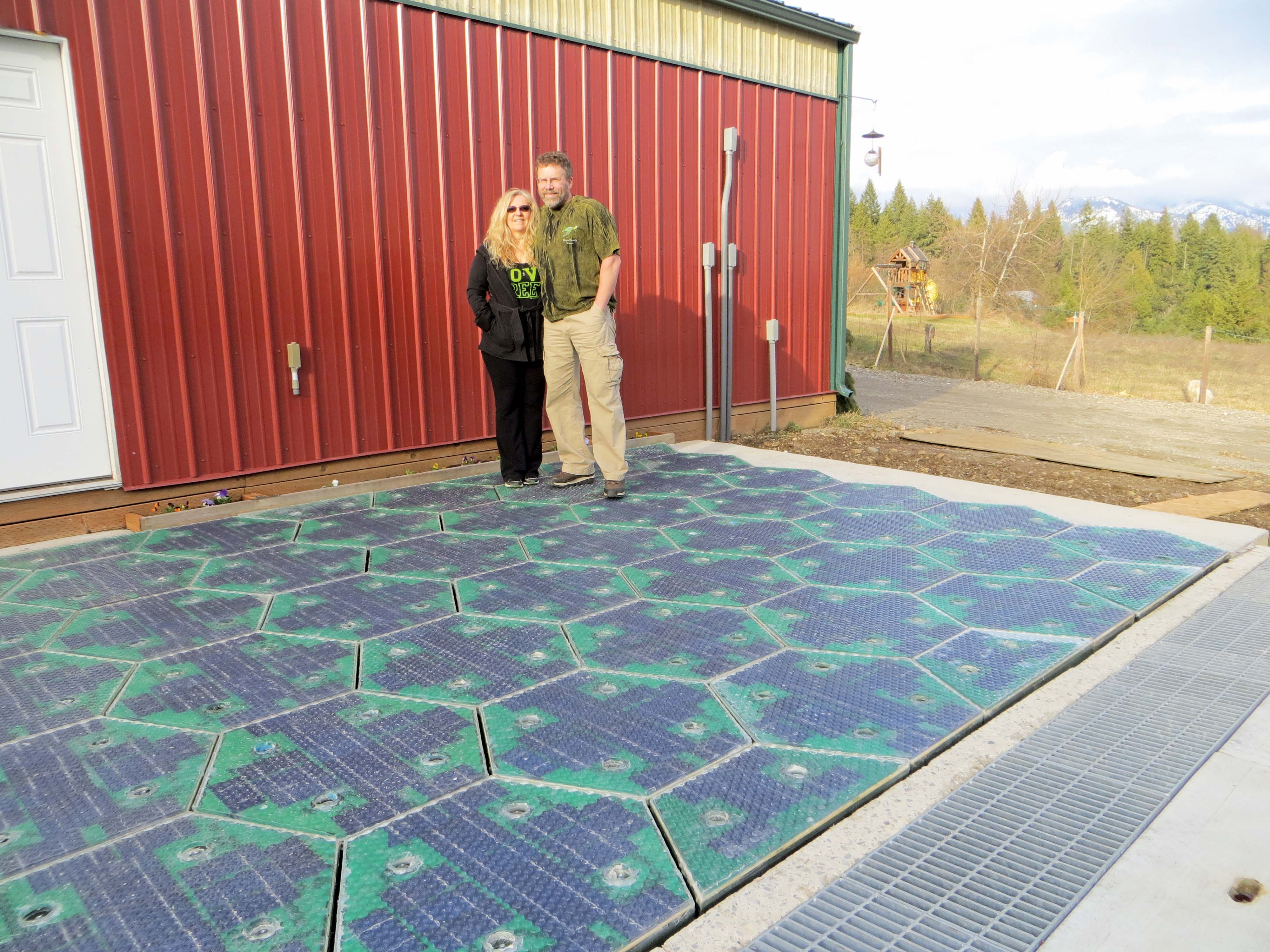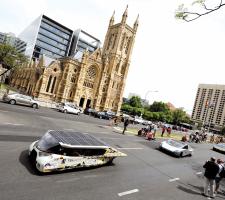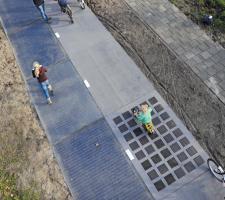
David Crawford looks at the sunny side of the street.
Solar power has been relatively slow in entering the transport sector, but a current blossoming of activity bodes well for the large-scale harnessing of an alternative energy that is zero-emission at source and, in practical terms, infinitely renewable. Traffic management and traveller information systems, and actual vehicles, are all emerging as areas for deployment. Meanwhile roads themselves are being viewed as new-style, fossil fuel-free ‘power stations’ for supplying, not just transport, but entire economies.
Solar energy is already playing useful roles in powering traffic signs and traveller information displays in remote areas, where laying cable for a conventional electricity supply can prove prohibitively expensive. In 2014
It has piloted this with the Massachusetts state Department of Transportation in the Cape Cod region, which experiences heavy traffic flows and resulting congestion during the summer tourist season. The company says it can generate annual electricity cost saving of around US$4,000 per sign and deliver a return on investment of between three and five years.
Canadian company International Solar Signal claims to be the first to have been created specifically to produce solar-powered traffic signals for use across the developing world. China-based Shenzen Noble has developed such signals as part of a wider product range and installed them in countries in Africa.
Solar bus time displays are sustaining rural public transport by creating confidence in service reliability. In the Gulf, the Dubai Roads and Transport Authority announced in June 2015 that it is planning 400 solarpowered bus shelters, taking advantage of the emirate’s typically blazing sunshine.
The authority is aiming progressively to raise transit’s modal share of travel from a low of 6% in 2006 to 20% in 2020 and 30% in 2030. Its shelters will offer up to 16 passengers at a time access to real-time travel information available from the RTA Public Transport Agency in air-conditioned comfort.
In Europe, Norfolk County Council has become the first UK local authority to deploy solar -powered bus stop information displays using low-power (low-cost) technology developed by transit information specialist
Cost remains an issue for public authorities in many countries as budgets for services continue to be squeezed.
One problem, admits Nexus Alpha CEO Patrick McDougall, is the visual clutter effect of square panels sitting on top of bus stops in environmentally sensitive areas. He has developed alternative types, on the basis that “with flexibility around panel sizes and shapes, the form of the array can become a positive design feature”.
Energy from the road
Far more dramatic is the prospect of road surfaces, exposed to the sun’s heat for much of the day, becoming power generators. Equipped with panels similar in concept to those used on roofs to power buildings - though more rugged - they could transform world energy prospects.Pioneers on both sides of the Atlantic already have projects under way. US engineer Scott Brusaw believes such roads could “virtually eliminate dependence on carbon-emitting fossil fuels for decades to come.”
Calculations by researcher James Hinton, a consultant to Infrastructure USA, indicate that the country’s 77,700 km2 of paved roads, paths and parking lots could, if covered by solar panels, support the energy needs of some 2.4bn people – eight times America’s current population. With a total of around 64.3million km of roadways across the world, it is interesting to speculate what could be generated globally. Of course not all roads would be suitable for solar generation, and those that are will not generate electricity all the time (raising the issue of energy storage). But there remains huge potential.
Brusaw’s Solar Roadways showcased a practical prototype of a solar parking lot in March 2014, with hexagonal panels embedding solar cells beneath polycarbonate and textured glass surfaces. The shape was chosen for flexibility in matching road curves and gradients.
In early load, traction, snow and impact resistance tests, the panels exceeded expectations. The project has gained financial support from the US Department of Transport’s Federal Highway Administration and crowdfunding, which drew donations from 165 countries. Current priorities include extended road testing and a panel production line. Brusaw envisages advanced products built into pedestrian crosswalks, with embedded load cells reacting to people’s presence and _ ashing warnings for motorists. These could also communicate with upstream panels, which would use embedded LEDs to show ‘SLOW DOWN’ messages. The embedded LEDs could also generate lane lines.
In Europe, the SolaRoad pilot by a consortium led by the Netherlands Organisation for Applied Scientific Research (TNO) completed the first of its three years of trialling in November 2015. The 70m-long by 1.75m-wide path has 122.5m2 of solar panels which generated 9,800kWh of energy in the first year - enough to power three households for a year. Results were “beyond our expectations”, sustainable infrastructure lead Dr Sten de Wit told ITS International. The specially-created cycle path in the village of Krommenie, in the province of Noord-Holland, has two lanes – one standard, the other solar. The former is left unequipped, to act as a reference point and test bed. Some 300,000 cyclists and moped riders used it over the first 12
months, without apparently experiencing any difficulty, said de Wit: “They barely realised that there was anything special, so we have already achieved our goal of public acceptance”.
A farm tractor hauling a heavy trailer crossed the lane without causing damage, and highway authorities from the Dutch provinces have satisfied themselves that it can carry the weight of, for example, verge mowing machinery. But further work remains to be done before the project moves on to trial cars.
The lane has crystalline silicon cells installed beneath a tempered glass top layer approximately 1cm thick, covered in turn by a similar thickness of translucent and skid-resistant coating. There were problems over the winter of 2014/15 with delamination of this coating from shrinkages in adverse weather, leading to its replacement. The plan for 2016 is to add a further 20m of lane length.
Partnering TNO and the provincial government are civil engineers Ooms Civiel and Netherlands-headquartered transport infrastructure developer
So far, the consortium has invested €3.5 million (US$4 million), including five years of work on panel development. The long-term goal is to deliver products that will pay for themselves in 15 years, and have a lifespan of at least another five. The consortium is currently exploring the scope for mass production to reduce costs which, says de Wit, “are not currently within the range of practicality.” Meanwhile, five potential follow-ups are in their early stages, three in The Netherlands and two in other countries; while Noord-Holland has signed a cooperation agreement with the US state of California.
The most productive roads will be those that carrying moderate to light traffic loads, rather than heavily used trunk routes. De Wit points that, of the Netherlands’ 140,000km of roads, 120,000km fall in the former category. He also stresses that, while panels would naturally need replacing over time, the concrete or asphalt subsurfaces would enjoy longer lifespans.
Solar Vehicles
Aircraft and boats have been stealing headlines on solar-powered vehicles. But cars are catching up thanks to events such as the biennial World Solar Challenge, last run in October 2015 on a 3,000km-plus route across Australia, with a new 'Cruiser' class bridging the gap between high-end technology and everyday driving.
The 2015 Challenge demonstrated that rooftop arrays are steadily becoming more aerodynamic. Judged on the criteria of solar km travelled, passenger km, speed, energy efficiency and design practicality, the category was won by the four-seater Stella Lux family car developed by the Solar Team at the Technical University of Eindhoven in The Netherlands.
In November 2015 the vehicle, with a range of up to 1,500km, arrived in China to join Shanghai's smart connected car programme.







